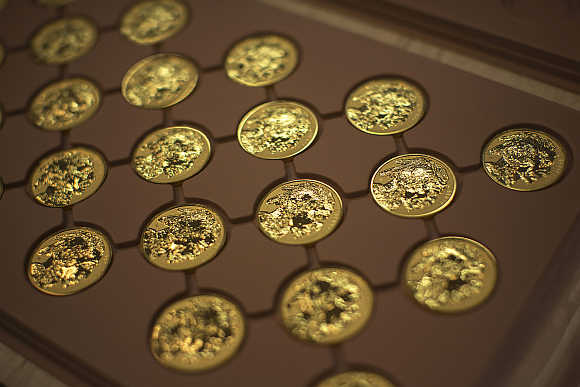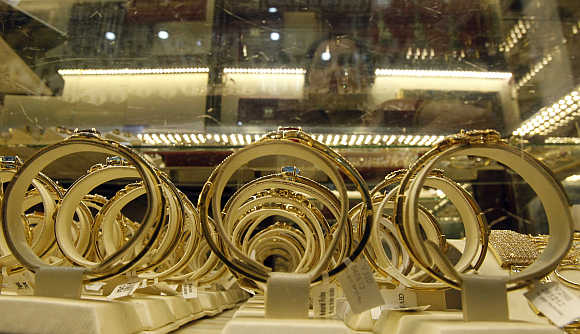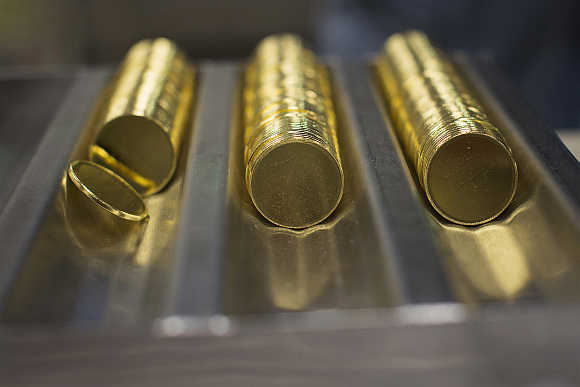 | « Back to article | Print this article |
Think gold is a poor investment? Try gold miners
While it has been a dreadful few months for gold bugs, it has been worse for investors in gold mining companies. Major gold miners have tended to perform worse than exchange traded funds not only during the sell-off of the precious metal since April, but also since the record high reached in September 2011.
Newcrest Mining Ltd, Australia's biggest gold miner, was the latest producer to disappoint investors, issuing a profit warning and announcing plans to slash up to $6 billion in asset values, reduce costs and cut planned expansions. The stock has shed almost 11 per cent of its value since the June 7 statement, adding to losses suffered in recent years.
Click NEXT to read more...
Think gold is a poor investment? Try gold miners
Newcrest shares fell to A$16.92 ($17.83) during the 2008 global financial crisis, before rallying 155 per cent to a high of A$43.17 in November 2010. Since then the stock has been pushed lower by 72 per cent as the company battled rising costs and a gold price that has trended lower.
Investors in the biggest gold ETF, the SPDR Gold Shares, have fared better, notwithstanding gold's recent woes. The 2008 recession low for the SPDR was $70, reached on November 12 of that year. The fund then surged 164 per cent to reach an all-time high of $184.58 on August 22, 2011, just before the record peak for spot gold.
Click NEXT to read more...
Think gold is a poor investment? Try gold miners
Since then the ETF has declined by 28 per cent, with by far the biggest portion of that coming this year, matching gold's slump of more than $300 an ounce between January and mid-April.
And the underperformance for gold equities isn't limited to Newcrest, with the world's biggest producer, Canada's Barrick Gold Corp, and number three, AngloGold Ashanti, also struggling.
Barrick, which closed on Tuesday at C$19.99 ($20.39), has lost 64 per cent of its value since its peak of C$55.25 on December 6, 2010. It also underperformed the SPDR's rally from the 2008 crisis, gaining 94 per cent from October of that year to the 2010 high.
Click NEXT to read more...
Think gold is a poor investment? Try gold miners
AngloGold Ashanti nearly matched the post-recession gains, jumping 156 per cent between October 2008 and December 2011. It has shed 57 per cent of its value since then, however.
While all three miners have had to deal with a falling gold price, they also have been faced with other challenges, some of their own making, which have negatively influenced investor perceptions. Barrick is embroiled in a dispute with the Chilean government over its massive Pascua-Lama project, having been ordered to halt work and fined $16 million for environmental violations.
The future of the $8.5 billion project is now in doubt and it runs the risk of being mothballed as Barrick, in common with the rest of the industry, seeks to cut capital expenditure.
Click NEXT to read more...
Think gold is a poor investment? Try gold miners
AngloGold Ashanti faces labour unrest at its South African mines, with a miner stabbed at its Mponeng mine on April 20, apparently in a dispute between workers that may be linked to a wider rivalry between unions.
Union demands for wage hikes of up to 60 per cent set the stage for further disruptions and unrest at South African mines, which may add to the risk discount in AngloGold Ashanti's share price.
What these three companies collectively show is that it appears inherently more risky and less rewarding investing in gold equities than in the actual metal. This stands in contrast to other commodities, crude oil for example.
Click NEXT to read more...
Think gold is a poor investment? Try gold miners
Exxon Mobil, the largest multi-national oil company, gained 68 per cent between its post-2008 low of $56.57 reached in July 2010 to its high of $93.48 on December 18 last year. It has since declined 3.2 per cent to close on June 11 at $90.46.
The US Oil Fund, the largest ETF tracking West Texas Intermediate futures, did perform better during the upswing, gaining 97 per cent between its post-2008 low in February 2009 and its peak in April 2011. However, since then it has lost 25 per cent of its value.
Click NEXT to read more...
Think gold is a poor investment? Try gold miners
The above analysis does exclude the impact of dividends, which will boost the total return offered by equities but aren't a feature for commodity ETFs. However, dividends paid by gold miners tend to be low, with Newcrest handing out 35 Australian cents in the 2012 financial year and Barrick 75 Canadian cents.
This isn't enough to offset the underperformance of the share price vis-a-vis the gold ETFs. It's clear that gold miners still have some way to go to convince investors that buying shares in a producer is a better investment than buying the physical metal.

© Copyright 2025 Reuters Limited. All rights reserved. Republication or redistribution of Reuters content, including by framing or similar means, is expressly prohibited without the prior written consent of Reuters. Reuters shall not be liable for any errors or delays in the content, or for any actions taken in reliance thereon.






